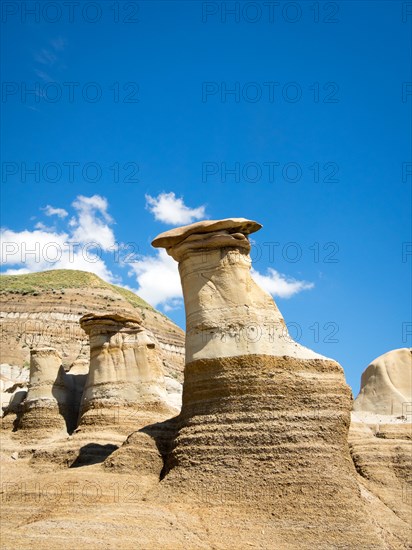
même sujet
Les cheminées de fées
Sujet
Hoodoos, striking geological formations, in the badlands just outside of Drumheller, Alberta, Canada.
Légende
A hoodoo (also called a tent rock, fairy chimney, and earth pyramid) is a tall, thin spire of rock that protrudes from the bottom of an arid drainage basin or badland. Hoodoos, which may range from 1.5 to 45 metres (4.9 to 147.6 ft), typically consist of relatively soft rock topped by harder, less easily eroded stone that protects each column from the elements. They generally form within sedimentary rock and volcanic rock formations. Hoodoos are found mainly in the desert in dry, hot areas. In common usage, the difference between hoodoos and pinnacles (or spires) is that hoodoos have a variable thickness often described as having a "totem pole-shaped body". Hoodoos range in size from the height of an average human to heights exceeding a 10-story building. Hoodoo shapes are affected by the erosional patterns of alternating hard and softer rock layers. Minerals deposited within different rock types cause hoodoos to have different colors throughout their height. Hoodoos in Drumheller, Alberta, Canada, are a distinctive feature that continues to attract thousands of visitors each year. The sediments comprising these hoodoos formed between 70 and 75 million years ago during the Cretaceous Period as clay and sand sediments from the Horseshoe Canyon Formation were deposited. These hoodoos are able to maintain a unique mushroom-like appearance as the underlying base erodes at a faster rate compared to the capstones, a rate of nearly one centimeter per year, faster than most geologic structures.
Info+
Photographe : Felix Choo
Date
18 juil. 2016
Crédit
Photo12/Alamy/Felix Choo
Notre référence
LMY20T04_GE6GWM
Utilisation
uniquement en France
Model release
Non
Property release
Non
Licence
Droits gérés
Format disponible
34,4Mo (2,0Mo) / 25,4cm x 33,9cm / 3005 x 4006 (300dpi)